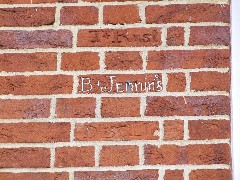| |
|
| |
|
This
handsome red brick building sits to the west of
Stowmarket town centre, set back from Bury
Street, in use for the same purpose today as when
it was built in 1813. This is an unusual date for
a chapel in East Anglia, and even though the
building was extended to its present form in the
more conventional year of 1836, at the time of
the Reform Acts and a burgeoning interest in
public worship, this makes it particularly worth
a look. Interestingly, the names of the original
covenanters are inscribed on bricks either side
of the upper storey west windows. The
Stowmarket Baptist congregation appears to have
begun life as a planted church from the Diss and
Shelfhanger congregation. A chapel was opened in
1796, but this was probably in a private house,
since the word 'erected' is not used in the
submitted return for the 1851 Census of Religious
Worship.
| Stowmarket Baptist church
began life as the Bethesda Particular
Baptist Chapel - that is to say, it did
not extend the privilege of communion to
those who had not undergone a believer's
baptism. TCB Timmins, in his commentary
on the Census, makes the interesting
point that while the Baptists had more
non-conformist chapels in Suffolk than
any other denomination, they were mainly
based in rural areas, and the Baptist
chapels in towns like Stowmarket
generally had smaller congregations than
other chapels. Thus, while 500 people
tipped up here on the afternoon of the
census, the Independent
Congregationalists on Ipswich Street
managed more than 800, and there were
even more than 600 at the Anglican parish
church - meanwhile, in the countryside,
the Baptist chapels easily outweighed
their Anglican neighbours in most
villages. Timmins suggests
that this may be because urban
populations tended to be more liberal,
and the 'Strict and Particular' strain in
Suffolk Baptist theology was more
attractive to rural people. Whatever,
that militancy survives to this day, when
Baptists have joined Anglicans and
Catholics in being the three big
denominations in the county, in
comparison with which all other
traditions and denominations are tiny.
There's a non-conformist lesson there,
perhaps.
|
|
 |
|
|
|
Simon Knott, April 2009
Amazon commission helps cover the running costs of this
site.
|
|
|

